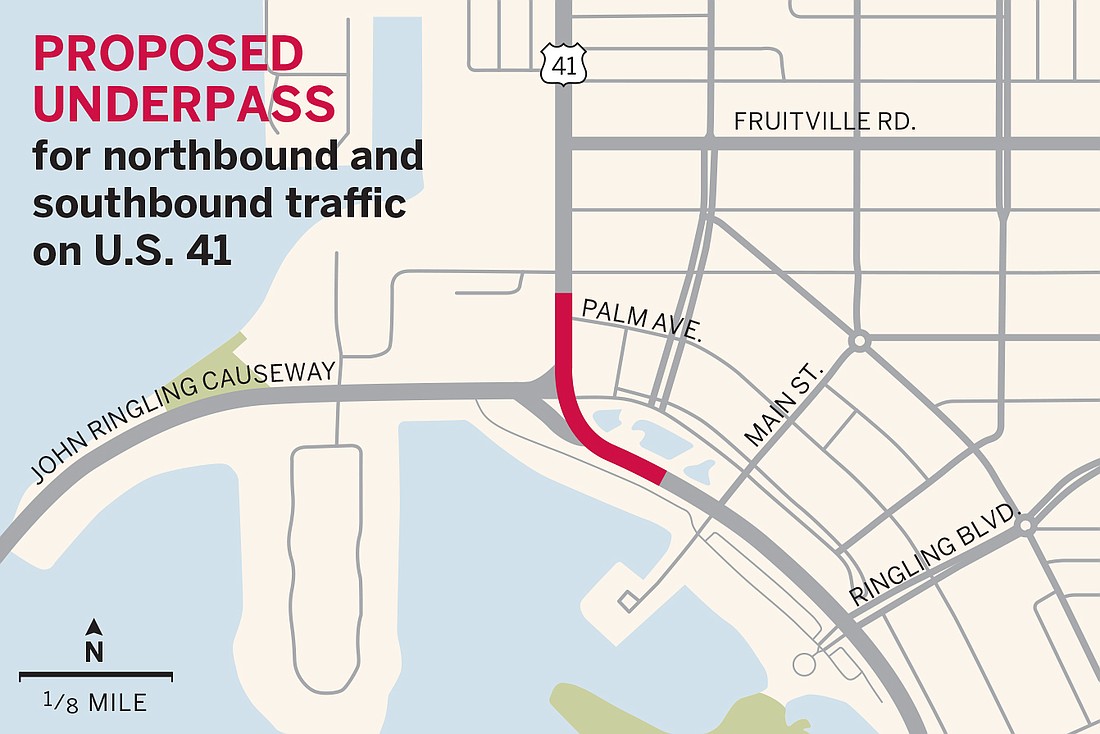- April 18, 2024
-
-
Loading

Loading

Adrian Moore
Opinion
Everyone knows there is a major clot in the roadway arterials of Sarasota. But Sarasota city engineer Alex DavisShaw says, “You can’t build your way out of congestion. It’s going to take some congestion and some discomfort before people make a choice to do something other than get in their car.”
To be sure, there are other sensible options than doing nothing. Indeed, it’s time for a radical long-term fix at the No. 1 choke points in the city of Sarasota: U.S. 41 and the John Ringling Causeway and U.S. 41 and Fruitville Road.
The delays at those intersections — as well as at others — generate enormous costs — thousands of hours per year, wasted fuel, lost work hours and the threat of scaring away the city’s economic engine: tourists and snowbirds.
The current long-range transportation plan calls for expanding the turn lane for those coming off of Ringling Causeway and turning south onto U.S. 41. This is totally inadequate; it will improve flow only for a tiny percentage of travelers.
Here’s what should happen: Build an underpass, allowing at least one lane in each direction of U.S. 41 to travel below the intersection. Northbound and southbound through-traffic on U.S. 41 would keep flowing, while on the surface drivers making turns in either direction or coming off of the Ringling Causeway would enjoy considerably less traffic.
This idea is not without precedent. Lee County has several intersections on Colonial Boulevard where lanes of through-traffic pass over major intersections.
An overpass would not work in downtown Sarasota, so an underpass is needed.
There are two such underpasses in South Florida: one on U.S. 1 in Fort Lauderdale and one on U.S. 27 in Hialeah, and they dramatically improve the flow of traffic.
Of course, there are some major challenges to creating an underpass or tunnel at this intersection.
It will be expensive. Based on estimates my colleagues made for Lee County in 2009, updating to current costs, this project would likely cost between $40 million and $45 million and likely incur annual operating costs for drainage and pumping.
For sure, that amount is considerably more than most of the projects in the current plan. But the traffic impacts would be much larger also.
Implementing tolls for the underpass lanes via Sunpass is an option for generating revenue to help offset costs. But because tolls would reduce the number of vehicles that use the underpass and thus make the project less effective at reducing congestion, I recommend delaying tolls until the underpass lanes become congested in the future.
In the meantime, construction and maintenance costs could be contained by building an underpass with a low clearance that restricts large vehicles such as commercial trucks and RVs from using the underpass lanes.
Free-flowing traffic north and south on U.S. 41 through the Ringling Causeway intersection would impact traffic at the intersection at Main Street to the south and Fruitville Road to the north. Existing plans to improve those intersections would need to take into account the effect of improved flow through the intersection in between.
The gradual ramp down for the underpass lanes would probably block left turns onto North Palm Avenue from southbound 41 and block drivers from going south on U.S. 41 from North Palm. But it would be easy for that traffic to use either First Street or Main to avoid that problem.
Finally, constructing these underpass lanes would likely be a major disruption. Careful planning and a bit more expense could help reduce the disruption. But ultimately it would have to be a more painful trip through that intersection during construction to have a less painful trip for many years to come.
The major advantage underpass lanes have over the alternatives is they allow more vehicles to travel through the intersection.
The alternatives all rely on hope that people will travel less by car in the future. But decades of high spending on public transit, walking and biking have not reduced the amount of travel by car one bit.
Prudent planning for the future requires us to plan for continued dominance of travel by cars. This project would have a big impact by improving flow in one of the major traffic chokepoints in the region, making it easier for residents and visitors alike to enjoy all the amenities Sarasota has to offer.
Dr. Adrian Moore lives on Siesta Key. He is vice president of the Reason Foundation and author of Mobility First: A New Vision for Transportation in a Globally Competitive Twenty-First Century.
The alternatives all rely on hope that people will travel less by car in the future. But decades of high spending on public transit, walking and biking have not reduced the amount of travel by car one bit.